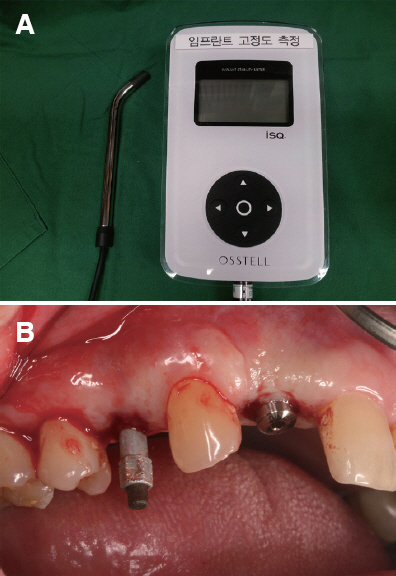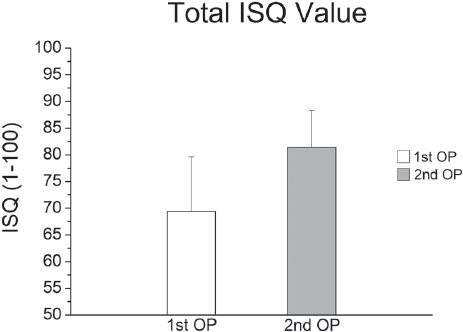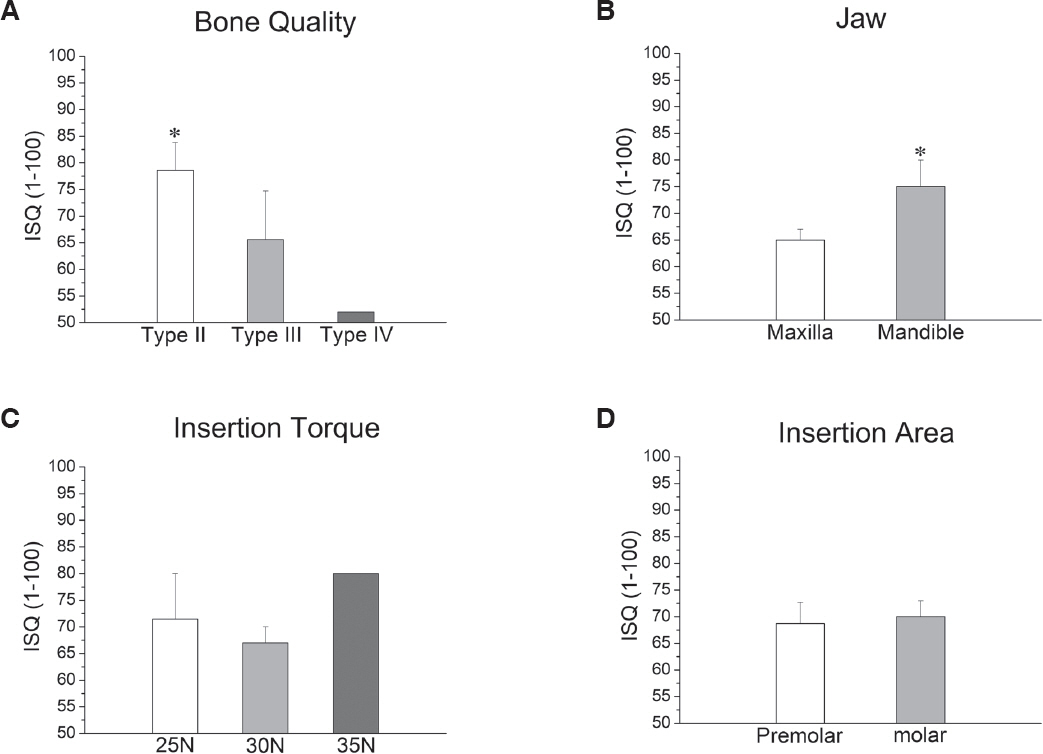J Dent Rehabil Appl Sci.
2018 Jun;34(2):80-88. 10.14368/jdras.2018.34.2.80.
Evaluation of the stability of sandblasted, large-grit, acid-etched implants with tapered straight body design
- Affiliations
-
- 1Department of Periodontology, School of Dentistry, Kyungpook National University, Daegu, Republic of Korea.
- 2Advanced Dental Device Development Institute, Kyungpook National University, Daegu, Republic of Korea. kblee@knu.ac.kr
- 3Department of Prosthodontics, School of Dentistry, Kyungpook National University, Daegu, Republic of Korea.
- KMID: 2422649
- DOI: http://doi.org/10.14368/jdras.2018.34.2.80
Abstract
- PURPOSE
Implant surface modification and implant design are the principle targets for achieving successful primary stability. The aim of this study was to measure implant stability quotient (ISQ) values of sandblasted, large-grit, acid-etched (SLA) implants with tapered straight body design during the healing period, and to determine the various factors affecting implant stability.
MATERIALS AND METHODS
To measure implant stability, resonance frequency analysis (RFA) was performed in 26 patients (13 women and 13 men) with 44 SLA implants with tapered straight body design. Implant stability (ISQ values) was evaluated at baseline and healing abutment connection (12 weeks), and the correlations between RFA and insertion torque (IT), bone quality, and jawbone were determined.
RESULTS
The mean ISQ value of the implants was 69.4 ± 10.2 at the time of implant placement (baseline) and 81.4 ± 6.9 at the time of healing abutment connection (P < 0.05). Significant differences were found between RFA and bone quality and between RFA and jawbone (P < 0.05). No significant differences were found between RFA and IT, insertion area, fixture diameter, and implant length (P > 0.05).
CONCLUSION
ISQ values of SLA implants with tapered straight body design were high at baseline and healing abutment connection. It was concluded that SLA implants with tapered straight body design show improved primary and secondary stability, and that immediate or early loading may be applicable.
Keyword
Figure
Reference
-
References
1. Meredith N. Assessment of implant stability as a prognostic determinant. Int J Prosthodont. 1998; 11:491–501. PMID: 9922740.2. Cochran DL, Schenk RK, Lussi A, Higginbottom FL, Buser D. Bone response to unloaded and loaded titanium implants with a sandblasted and acidetched surface:a histometric study in the canine mandible. J Biomed Mater Res. 1998; 40:1–11. DOI: 10.1002/(SICI)1097-4636(199804)40:1<1::AID-JBM1=3.0.CO;2-Q. PMID: 9511093.3. Brunski JB. Biomechanical factors affecting the bone-dental implant interface. Clin Mater. 1992; 10:153–201. DOI: 10.1016/0267-6605(92)90049-Y. PMID: 10149982.4. Sennerby L, Roos J. Surgical determinants of clinical success of osseointegrated oral implants:a review of the literature. Int J Prosthodont. 1998; 11:408–20. PMID: 9922733.5. Klokkevold PR, Nishimura RD, Adachi M, Caputo A. Osseointegration enhanced by chemical etching of the titanium surface. A torque removal study in the rabbit. Clin Oral Implants Res. 1997; 8:442–7. DOI: 10.1034/j.1600-0501.1997.080601.x. PMID: 9555202.6. Piattelli A, Manzon L, Scarano A, Paolantonio M, Piattelli M. Histologic and histomorphometric analysis of the bone response to machined and sandblasted titanium implants:an experimental study in rabbits. Int J Oral Maxillofac Implants. 1998; 13:805–10. PMID: 9857591.7. Yeo IS, Han JS, Yang JH. Biomechanical and histomorphometric study of dental implants with different surface characteristics. J Biomed Mater Res B Appl Biomater. 2008; 87:303–11. DOI: 10.1002/jbm.b.31104. PMID: 18435399.8. Glauser R, Sennerby L, Meredith N, Rée A, Lundgren A, Gottlow J, Hämmerle CH. Resonance frequency analysis of implants subjected to immediate or earlyfunctional occlusal loading. Successful vs. failing implants. Clin Oral Implant Res. 2004; 15:428–34. DOI: 10.1111/j.1600-0501.2004.01036.x. PMID: 15248877.9. Meredith N, Alleyne D, Cawley P. Quantitative determination of the stability of the implant-tissue interface using resonance frequency analysis. Clin Oral Implants Res. 1996; 7:261–7. DOI: 10.1034/j.1600-0501.1996.070308.x. PMID: 9151590.10. Sim CP, Lang NP. Factors influencing resonance frequency analysis assessed by Osstell mentor during implant tissue integration:I. Instrument positioning, bone structure, implant length. Clin Oral Implants Res. 2010; 21:598–604. DOI: 10.1111/j.1600-0501.2009.01878.x. PMID: 20666786.11. Ostman PO, Hellman M, Wendelhag I, Sennerby L. Resonance frequency analysis measurements of implants at placement surgery. Int J Prosthodont. 2006; 19:77–83. PMID: 16479765.12. Rowan M, Lee D, Pi-Anfruns J, Shiffler P, Aghaloo T, Moy PK. Mechanical versus biological stability of immediate and delayed implant placement using resonance frequency analysis. J Oral Maxillofac Surg. 2015; 73:253–7. DOI: 10.1016/j.joms.2014.09.024. PMID: 25579008.13. Guler AU, Sumer M, Duran I, Sandikci EO, Telcioglu NT. Resonance frequency analysis of 208 Straumann dental implants during the healing period. J Oral Implantol. 2013; 39:161–7. DOI: 10.1563/AAID-JOI-D-11-00060. PMID: 22103915.14. Boronat López A, Balaguer Martínez J, Lamas Pelayo J, Carrillo García C, Peñarrocha Diago M. Resonance frequency analysis of dental implant stability during the healing period. Med Oral Patol Oral Cir Bucal. 2008; 13:E244–7. PMID: 18379449.15. Rabel A, Köhler SG, Schmidt-Westhausen AM. Clinical study on the primary stability of two dental implant systems with resonance frequency analysis. Clin Oral Investig. 2007; 11:257–65. DOI: 10.1007/s00784-007-0115-2. PMID: 17401588.16. Trisi P, Perfetti G, Baldoni E, Berardi D, Colagiovanni M, Scogna G. Implant micromotion is related to peak insertion torque and bone density. Clin Oral Implants Res. 2009; 20:467–71. DOI: 10.1111/j.1600-0501.2008.01679.x. PMID: 19522976.17. Barone A, Alfonsi F, Derchi G, Tonelli P, Toti P, Marchionni S, Covani U. The Effect of Insertion Torque on the Clinical Outcome of Single Implants:A Randomized Clinical Trial. Clin Implant Dent Relat Res. 2016; 18:588–600. DOI: 10.1111/cid.12337. PMID: 26043651.18. Lai HC, Zhuang LF, Zhang ZY. Stability of implants placed in different bone types. Zhonghua Kou Qiang Yi Xue Za Zhi. 2007; 42:292–3. PMID: 17686282.19. Turkyilmaz I, Sennerby L, McGlumphy EA, Tözüm TF. Biomechanical aspects of primary implant stability:a human cadaver study. Clin Implant Dent Relat Res. 2009; 11:113–9. DOI: 10.1111/j.1708-8208.2008.00097.x. PMID: 18422713.20. Huang HM, Lee SY, Yeh CY, Lin CT. Resonance frequency assessment of dental implant stability with various bone qualities:a numerical approach. Clin Oral Implants Res. 2002; 13:65–74. DOI: 10.1034/j.1600-0501.2002.130108.x. PMID: 12005147.21. Friberg B, Sennerby L, Meredith N, Lekholm U. A comparison between cutting torque and resonance frequency measurements of maxillary implants. A 20-month clinical study. Int J Oral Maxillofac Surg. 1999; 28:297–303. DOI: 10.1016/S0901-5027(99)80163-5. PMID: 10416900.22. Bischof M, Nedir R, Szmukler-Moncler S, Bernard JP, Samson J. Implant stability measurement of delayed and immediately loaded implants during healing. Clin Oral Implants Res. 2004; 15:529–39. DOI: 10.1111/j.1600-0501.2004.01042.x. PMID: 15355394.23. Horwitz J, Zuabi O, Peled M. Resonance frequency analysis in immediate loading of dental implants. Refuat Hapeh Vehashinayim. 2003; 20:80–8. PMID: 14515631.24. Polizzi G, Rangert B, Lekholm U, Gualini F, Lindström H. Brånemark System Wide Platform implants for single molar replacement:clinical evaluation of prospective and retrospective materials. Clin Implant Dent Relat Res. 2000; 2:61–9. DOI: 10.1111/j.1708-8208.2000.tb00107.x. PMID: 11359265.25. Calandriello R, Tomatis M, Vallone R, Rangert B, Gottlow J. Immediate occlusal loading of single lower molars using Brånemark System Wide-Platform TiUnite implants:an interim report of a prospective open-ended clinical multicenter study. Clin Implant Dent Relat Res. 2003; 5:74–80. DOI: 10.1111/j.1708-8208.2003.tb00018.x. PMID: 12691653.26. Barewal RM, Oates TW, Meredith N, Cochran DL. Resonance frequency measurement of implant stability in vivo on implants with a sandblasted and acid-etched surface. Int J Oral Maxillofac Implants. 2003; 18:641–51. PMID: 14579951.27. Balleri P, Cozzolino A, Ghelli L, Momicchioli G, Varriale A. Stability measurements of osseointegrated implants using Osstell in partially edentulous jaws after 1 year of loading:a pilot study. Clin Implant Dent Relat Res. 2002; 4:128–32. DOI: 10.1111/j.1708-8208.2002.tb00162.x. PMID: 12516644.28. Lazzara R, Siddiqui AA, Binon P, Feldman SA, Weiner R, Phillips R, Gonshor A. Retrospective multicenter analysis of 3i endosseous dental implants placed over a five-year period. Clin Oral Implants Res. 1996; 7:73–83. DOI: 10.1034/j.1600-0501.1996.070109.x. PMID: 9002825.29. Nedir R, Bischof M, Szmukler-Moncler S, Bernard JP, Samson J. Predicting osseointegration by means of implant primary stability. Clin Oral Implants Res. 2004; 15:520–8. DOI: 10.1111/j.1600-0501.2004.01059.x. PMID: 15355393.
- Full Text Links
- Actions
-
Cited
- CITED
-
- Close
- Share
- Similar articles
-
- A comparative clinical study on oxidized titanium implants and sandblasted large-grit acid etched implants in soft bone
- The cumulative survival rate of sandblasted, large-grit, acid-etched dental implants: a retrospective analysisThe cumulative survival rate of sandblasted, large-grit, acid-etched dental implants: a retrospective analysis
- Retrospective clinical study of an implant with a sandblasted, large-grit, acid-etched surface and internal connection: analysis of short-term success rate and marginal bone loss
- The Effect of N-acetyl cysteine (NAC) loading on the bone formation surrounding sandblastedand large-grit and acid-etched implants in the dog: A pilot study
- Scanning Electron Microscopic Study of the Effects of Citric Acid on the Change of Implant Surface According to Application Time







